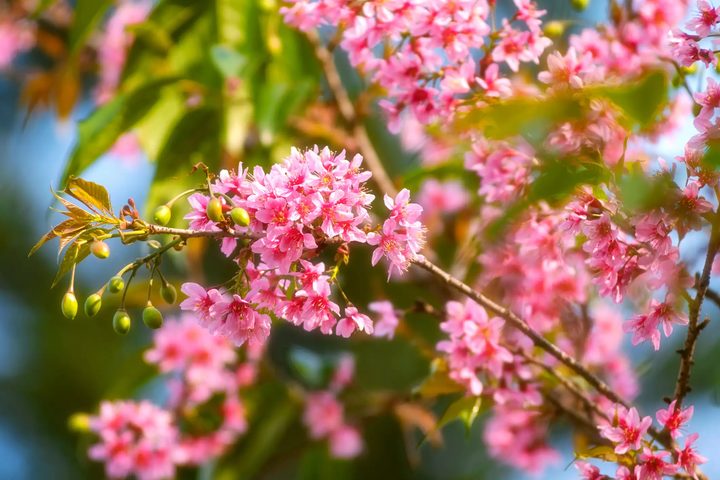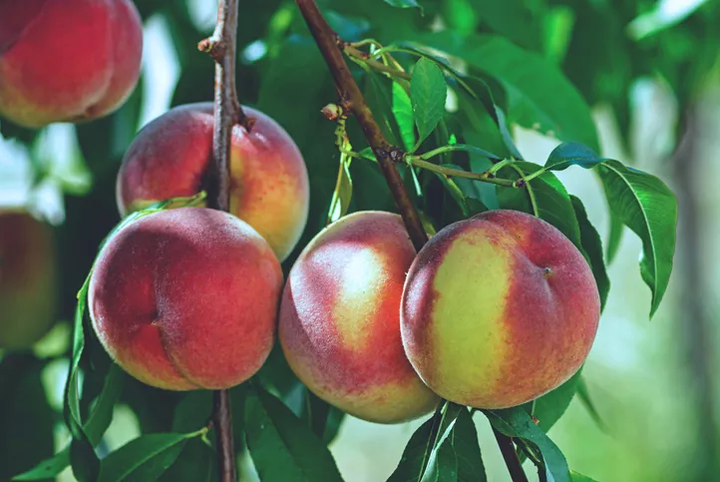Every year, the Environmental Working Group publishes a list of the "dirty dozen" produce items that contain the most pesticide residue, and peaches are usually in the top half of that list. If you don't want to give up the succulent taste of a fresh summer peach, consider growing your own peach tree. By growing peaches, you can also grow thin-skinned types that are too delicate to make it to supermarket shelves but will make a great addition to your breakfast table or snack time. Peach trees come in all sizes, even dwarf cultivars that you can grow in a container, so there's nothing stopping you from nurturing a peach crop that you can add to cobblers, canned preserves, smoothies, or salsa.
Botanical Name:
Prunus persica
Common Name:
Peach
Plant Type:
Perennial tree
Mature Size:
Four to six feet for dwarf trees; 25 feet for standard trees
Sun Exposure:
Full sun
Soil Type:
Sandy and well-draining
Soil pH:
Acidic; 6.0-6.5
Bloom Time:
Spring
Flower Color:
Pink
Hardiness Zones:
4 to 9
Native Area:
China

How to Grow Peach Trees
Peach trees don't require the same kind of helicopter parenting a vegetable garden does, but they do need regular tending to be at their healthiest and most productive. Peaches need careful attention to shaping and pruning, especially in the first two years of growth. Peaches also need protection from insects, which love peaches as much as we do.
Light
Peach trees need full sun. Peach trees growing in shade lose their vigor, making them susceptible to pest and disease problems. Ensure that peach trees have the proper spacing to prevent them from shading each other at maturity. Plant standard peaches 18 feet apart, and dwarf peaches five feet apart.
Soil
Peach trees need good drainage, and like their soil on the sandy side. Adding an organic mulch like leaf mold or compost helps suppress weeds, and keeps the soil at a healthy, slightly acidic level. A slightly elevated site is better than a depression where frost settles.
Water
Keep peach trees evenly moist, especially in the first year as they establish themselves.
Temperature and Humidity
Peaches like moderate temperatures, and grow best in USDA growing zones 5-8. However, you can select varieties that are more cold or heat tolerant to expand one growing zone in either direction. Peaches need at least 600 chilling hours at 45 degrees Fahrenheit or lower to trigger fruiting. Extended temperatures below zero may damage the trees. Peaches tolerate humid conditions, but excessive wetness can encourage fungal diseases.
Fertilizer
Apply a balanced 10-10-10 fertilizer around your peach trees each spring. Use a pound for new trees, and add a pound each year, up to ten pounds for mature standard peaches.
Propagating
The easiest way to propagate a non-grafted tree is through softwood cuttings. Take a nine-inch cutting in the spring, when growth is soft and green. Dip it in rooting hormone to help the cutting take. Plant the cutting in sterile potting medium, and keep moist. Roots will form in a month.
Varieties of Peach Trees

While peach trees can produce clingstone or freestone fruits, most varieties sold for home gardens are freestone. You can also choose between yellow or white flesh, and early or late-bearing peach trees. 'Halehaven' is a very sweet midseason variety; even the skin is said to be sweet, and the trees are vigorous. 'Reliance' is an early season producer, good for cold regions. Donut-shaped peaches like 'Galaxy' and 'Saturn' have sweet white flesh. Dwarf peach trees like 'Bonanza' only reach six feet tall, but produce full-sized fruit.
Toxicity of Peach Trees
The stems, leaves, and seeds of peach trees contain cyanide, which is highly toxic to animals and people. Consumption may cause difficulty breathing or shock.
Pruning
It may be difficult to remove so many healthy branches from a thick, bushy peach tree, but proper pruning of peach trees is vital to managing the fruit size and increasing light to fruit-bearing branches. When pruning a peach tree, the finished look of the branches should have a herringbone pattern with an open center, like a vase. Perform pruning in July, removing upright shoots that shade fruiting branches in the tree's interior. The abundance of light that you allow to reach these fruiting branches following pruning is important to the development of next season's flower buds.
Harvesting
Peach trees, even young specimens, don't take long to be fruitful in the landscape. Following their showy pink spring blooms, peach trees will exhibit many tiny green peaches in the early summer months. However, in addition to the natural fruit drop that peach trees do in this stage of development, you must also thin your crop, or face the disappointment of walnut-sized fruit at harvest time. Remove all but the largest fruits from each branch, leaving at least six inches between fruits.
Being Grown in Containers
Dwarf peach trees make great container specimens. Choose a container at least three feet across. Never let your peach tree container dry out. Protect the peach tree container from hard freezes in a sheltered area like a garage or shed.
Growing From Seeds
Peach pits will grow outdoors with little intervention from people. Plant the seed three inches deep outdoors in the fall. Cold winter temperatures will allow the embryo to mature. The seed will germinate in the spring, and you can transplant your young tree to its permanent location.
Common Pests/Diseases
The most significant peach tree pest is the peach tree borer. This clear wing moth resembles a wasp, and deposits its eggs on tree bark in the fall. The grubs hatch and burrow into the trunk, where they feed on the trunk and roots. Look for a jelly-like sap at the entry hole, and impale grubs with a wire.
A fungus causes peach tree leaf curl, leading to leaf browning and deformity. Use a copper-based fungicide in late fall or early spring to prevent and control this fungus.
Peach Trees vs Nectarine Trees
As a tree, peaches and nectarines are the same species, Prunus persica. Nectarine fruit is fuzz-free, and somewhat smaller and sweeter than the peach. Peach trees may sometimes grow nectarines, and nectarine trees may grow peaches, but professional growers control their crop by growing grafted branches that previously produced nectarines, and grafting them onto peach trees. Fuzziness is a dominant trait, but if your peach trees decide to go rogue and produce a nectarine crop, consider it a two-for-one bonus.